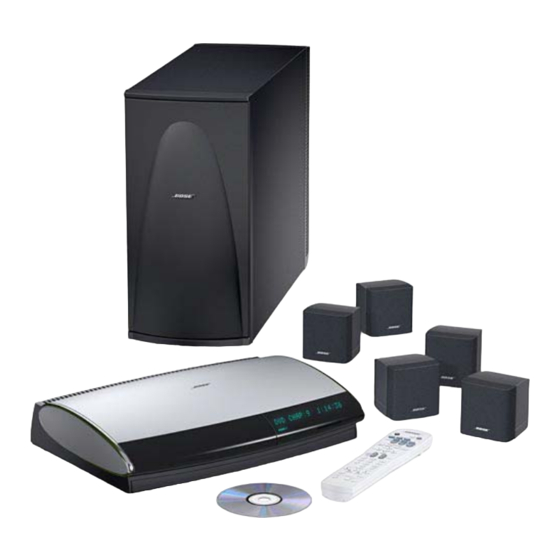Bose Lifestyle PS48 Procedura di prova - Pagina 3
Sfoglia online o scarica il pdf Procedura di prova per Altoparlanti Bose Lifestyle PS48. Bose Lifestyle PS48 5. Digital acoustimass powered speakers
Anche per Bose Lifestyle PS48: Manuale di servizio (43 pagine)

PS28/48 Performance Verification Procedures
(With AV28 Media Center Console)
Test Setup
®
Using the Lifestyle
28/48 system's audio input
cable part number 260351-001, connect the
AV28 media center to the PS28/48 bass
module.
1. Sweep Test
1.1 Apply a 200 mVrms, 25 Hz signal to the left
and right AUX input of the AV28 media center.
Adjust the AV28 media center to full volume.
Listen for any extraneous noises such as
rubbing, scraping, or ticking coming from the
bass module.
Note: No extraneous noises such as rubbing,
scraping or ticking should be heard. To distin-
guish between normal suspension noise, rubs
and ticks, displace the woofer cone with your
finger. If the sound can be made to go away or
get worse, it's a rub or tick and the woofer
should be replaced. If the noise stays the
same, it's normal suspension noise and it will
not be heard with regular program material.
1.2 Sweep the bass module from 40 Hz to 300 Hz.
Listen carefully for any buzzes, rattles
or extraneous noises coming from the bass
module.
Note: Redress any wire or component that
buzzes.
2 Bass Module Air Leak Test
2.1 Apply a 200 mVrms, 40 Hz signal to the
AUX input of the AV28 media center.
2.2 Check for air leaks from the bass module
cabinet. Listen near the areas where the plastic
seals to the wood.
3. Cube Speaker Phase Test
Note: The DC voltage should only be momen-
tarily applied to the cube speaker input to avoid
damaging the speakers.
3. 1 Observing polarity, momentarily apply 8 Vdc to
the input of the cube speaker.
Note: Connect the positive side of the dc
supply to the positive input of the cube. Con-
nect the negative side of the dc supply to the
negative input of the cube speaker.
3.2 The speakers should move outward with
the application of the dc voltage. Check the
cube wiring if it moves inward.
4. Cube Speaker Sweep Test
4.1 Apply an 11 Vrms, 20 Hz signal directly to
the input of the satellite. Change the applied
signal to 8 Vrms, 150 Hz and the sweep the
oscillator from 150 Hz to 2 kHz.
4.2 Listen for rubs, ticks, air leaks, buzzes or
other extraneous noises.
Note: Defects such as rubs, ticks and air leaks
will typically be most audible during the 20 Hz
test. Defects such as buzzes will typically be
heard during the 150 Hz to 2 kHz sweep.
Note: The satellite cubes are not repairable.
®
The Jewel Cube
speakers are repairable.
5. Listening Test
5.1 Connect the cube speakers to the outputs
of the bass module.
5.2 Adjust the volume to a comfortable level
and listen for a clean undistored audio output
from the bass module and cube speakers.
3
